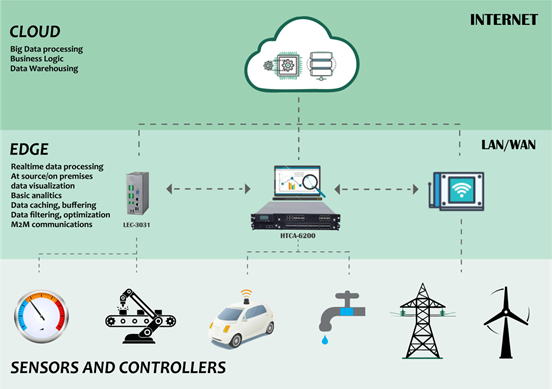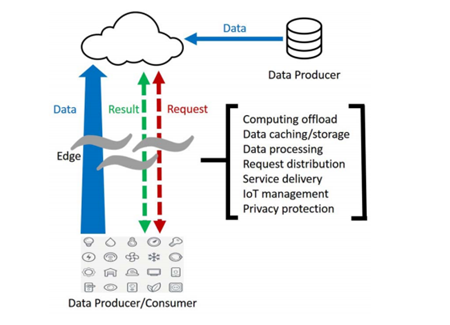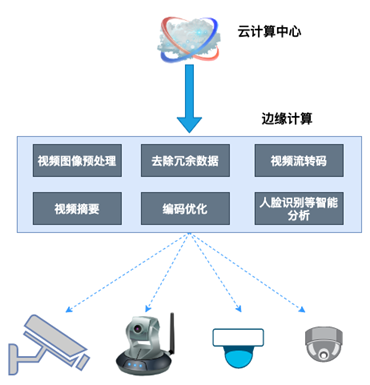Traditional cloud computing involves receiving data locally, transmitting it to the cloud for processing, and then sending the results back to the edge. This is an integrated processing method. The cloud computing approach requires devices to be online in real-time and necessitates the transfer of large volumes of data.
For applications with the following constraints, the cloud computing method is clearly unsuitable, and edge computing must be considered as a solution.
1) Areas with bottlenecks in real-time connectivity and high network connection costs (high bandwidth and energy costs);
2) Applications with high real-time response requirements, such as autonomous vehicles, where even a slight network delay can lead to disaster;
3) High importance of data, such as company confidential information, which is vulnerable to attacks when stored in the cloud;
With the development of the Internet of Things, the data generated at the network edge is gradually increasing, and cloud computing is not always efficient. If we can process and analyze data at the network edge nodes, this computing model would be more efficient.

The push from cloud services: Cloud centers have powerful processing capabilities and can handle massive amounts of data. However, transmitting massive amounts of data to the cloud center has become a challenge. The performance bottleneck of the cloud computing model lies in the limited network bandwidth; transmitting large amounts of data takes time, and processing data at the cloud center also requires time, which increases request response times and results in poor user experience.
The push from the Internet of Things: Almost all electronic devices can now connect to the Internet, generating vast amounts of data. The traditional cloud computing model cannot process this data in a timely and efficient manner. Processing this data at edge nodes will lead to minimal response times, reduce network load, and ensure the privacy of user data.
The role shift of terminal devices: Most of the time, terminal devices act as data consumers, such as using smartphones to watch iQIYI or browse Douyin. However, smartphones now also enable terminal devices to generate data, such as purchasing items on Taobao or searching for content on Baidu, which are all data generated by terminal nodes.

Figure 1: Traditional Cloud Computing Paradigm

Figure 2: Edge Computing Paradigm
Edge computing refers to processing and analyzing data at the network edge nodes. Here, we define edge nodes as any nodes with computing and network resources between the data generation source and the cloud center. For example, a smartphone is an edge node between the user and the cloud center, and a gateway is an edge node between smart homes and the cloud center. In an ideal environment, edge computing means analyzing and processing data near the source of data generation, without data transfer, thereby reducing network traffic and response times.
(1) Cost Reduction
Edge computing can reduce connectivity and improve network transmission efficiency, lowering network communication costs. The overall system’s energy consumption decreases by 30%-40% and can reduce the time for data integration and migration by 20 times.
(2) Security
By utilizing artificial intelligence in scenarios such as surveillance cameras, independent vehicles, and aircraft, information becomes relevant to users. Since edge AI manages data locally and does not store large amounts of cloud data, the risk of privacy attacks is reduced.
(3) Responsive
Compared to centralized IoT models, edge AI systems can process data extremely quickly. This requires real-time operations, such as data development, decision-making, and intervention, making it very suitable for millisecond-level applications, such as autonomous vehicles; in the field of facial recognition, response times have decreased from 900ms to 169ms.
(4) Ease of Management
Edge AI systems are independent and do not require management by data scientists or AI developers. Information and observations can be automatically distributed or provided on-site through highly visual interfaces or dashboards.
Based on the above characteristics, in the context of the continuous development of the Internet of Things, edge computing effectively compensates for the shortcomings of traditional cloud computing models, extending the capabilities of central clouds to the edge, covering more application scenarios.
(1)Public Safety

Public safety impacts the lives of the public from various aspects, such as fire safety and transportation. For example, rideshare drivers harassing passengers or even committing criminal acts. To further enhance safety, we ultimately rely on technologies like video, which will lead to high bandwidth demands. Based on Uber’s 2017 usage (45787 times/minute), if we assume that each ride’s video is sent to the cloud (each ride lasting 20 minutes), the cloud would add 9.23 PB of video data daily. Edge computing, as a near data source computation, can significantly reduce data bandwidth and address video data processing issues in the public safety sector.
Based on edge computing, a video usefulness detection system can analyze and judge video content at the front end or near the video source. The video alarm function is triggered under specific conditions—such as abnormal driving behavior, like deviating from the lane or arguments occurring inside the vehicle. This allows for pre-processing of data, avoiding video uploads during critical safety periods, significantly reducing data loss. This transforms terminal devices from passive monitoring to an active analysis and warning security terminal system.
Based on edge computing, a fire-fighting system can deploy edge servers on fire trucks to receive data from infrared cameras and various sensors (such as indoor positioning systems), processing firefighter location information and surrounding conditions in real-time, visualizing it for on-site command, and pushing it to remote control centers to ensure firefighter safety.
(2)Smart Home
With the development of IoT technology, smart home systems have further evolved, utilizing numerous IoT devices (such as temperature and humidity sensors, security systems, lighting systems) to monitor the internal status of homes in real-time, receiving external control commands, and ultimately regulating the home environment to enhance safety, convenience, and comfort. However, as the number of smart home devices increases and these devices are often heterogeneous, managing these heterogeneous devices remains a pressing issue, such as device naming, data naming, and intelligent linkage between devices. Additionally, due to the privacy of home data, users are not always willing to upload data to the cloud for processing, especially internal home video data. Edge computing can push computation (home data processing) to internal home gateways, reducing the outflow of home data, thereby lowering the risk of data leakage and enhancing system privacy.
Academia also has numerous scholars constructing smart home systems based on the concept of edge computing.
Edge Operating System for Home (EdgeOSH): Inspired by edge computing, edge servers are set up in homes to process data at the network edge using EdgeOSH. EdgeOSH consists of multiple modules: the communication module is responsible for interconnecting smart home devices, adapting to various protocols commonly used in smart homes; the data management module manages all home data, integrating and processing the data; the self-management module provides device management and management between smart home services to create an intelligent home environment.
(3)Smart City
Smart cities utilize advanced information technology to achieve intelligent management and operation of cities. In 2016, Alibaba Cloud proposed the concept of a “City Brain,” essentially using urban data resources to better manage cities. However, the construction of smart cities relies on data that is diverse and heterogeneous, while also involving the privacy and security of urban residents. Therefore, applying an edge computing model to process data at the network edge is a good solution.